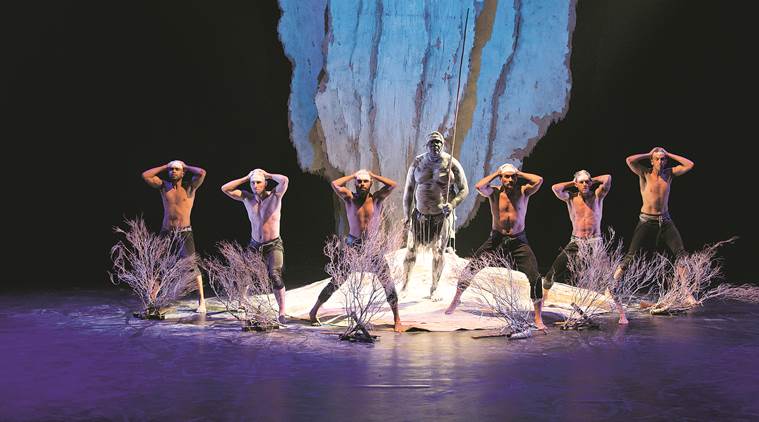Fire to the Rain
Currently in India as part of the Oz fest, they bring narratives that are centuries old. They turn 30 next year, having performed at the opening and closing ceremonies of the summer 2000 Olympics and at the recent Commonwealth Games.

Bangarra Dance Company’s Black Ochres Juhny-Boy Borja
Their name literally means ‘to make fire’ in Wiradjuri language. Bangarra Dance Theatre, an indigenous Australian contemporary dance company does just that — they set the stage on fire with their moves. Currently in India as part of the Oz fest, they bring narratives that are centuries old. They turn 30 next year, having performed at the opening and closing ceremonies of the summer 2000 Olympics and at the recent Commonwealth Games. We speak with Philippe Magid, Executive Director of Bangarra Dance Theatre. Excerpts:
Can you tell us about your programme in India?
Stephen Page, artistic director of Bangarra, has curated a unique programme called ‘Spirit 2018’. It is a collection of stories and songlines drawn from all over Australia. We have blended traditional and contemporary pieces that showcase the incredible strength and artistry of our 18 dancers.
You are also conducting workshops in India.
Before our performances in Delhi, Mumbai and Bangalore, we are visiting three indigenous tribal communities in Aizawl (Mizoram), Purulia (West Bengal) and Bhopal (Madhya Pradesh). Through this, Bangarra dancers will learn about the traditional dances of those areas, such as the Chhau mask dance in Purulia, and the Karma dance of the Baigas. We are also leading workshops for young, professional dancers, where we will share Aboriginal and Torres Strait Islander knowledge, stories and dance.
Bangarra works with indigenous people, who share stories with you. How do you select these stories?
We are very fortunate that Aboriginal and Torres Strait Islander communities across Australia trust us with their stories, music, songs and dances. We do this through a detailed and complex residency programme where we visit communities and spend time with senior cultural leaders, who then grant us permission to tell their stories. The knowledge that we are entrusted with, informs the development of the work. On returning to our studios, we work with our creative team to develop a production. One of the most important parts of the entire process is ensuring that once the works have been performed across Australia, they are returned to the communities from which they originated. We take them back to the country from which they came and perform them for the people there.
What are your other production themes and narratives?
All of our works are grounded in indigenous storytelling but also reflect contemporary social issues. In 2013, Jasmin Sheppard choreographed Macq, a work that looks at the 1816 Appin Massacre. Performing this work today is important, as it raises awareness about the need for Australia to confront the brutality of its colonial past, while also educating audiences about the resilience of a culture which survived such atrocities. Dark Emu, our most recent work, is inspired by Bruce Pascoe’s award-winning book of the same name. It’s a historical account of the sophisticated farming, fishing and land management practices of Aboriginal people and Torres Strait Islanders. Last year, Stephen created a beautiful and extraordinary full-length narrative work that explored the life of one of history’s most iconic Aboriginal figures.
A Bangarra production incorporates various forms including yoga, pilates and ballet. How do you achieve that?
All of our dancers are trained artistes who have a rigorous dance training programme. Our safe dance practice includes physiotherapy, pilates, yoga, ballet, contemporary and other dance forms. Our dance language has evolved over the last 30 years and is a unique combination of traditional Aboriginal and Torres Strait Islander movement mixed with more conventional dance languages.
Tell us about your memorable performances?
For our 25th anniversary, we presented an outdoor performance on the forecourt of the Sydney Opera House. It rained all afternoon but 5,000 people still braved the elements to see us. For me personally, however, the most memorable performances are always those when the company performs back in the country, for the communities who have shared their stories. Last month, we performed Nyapanyapa, a story based on the life and work of Yolngu artist Nyapanyapa Yunupingu. We performed this work on a basketball court in remote North East Arnhem Land and she was in attendance, along with 1,000 members from the Yolngu community to which she belongs.
Bangarra Dance Theatre will be performing in Delhi at the Qutub Minar on October 25, and Mumbai on November 1 at NCPA. Register at Bookmyshow






















 Philippe Magid (Tiffany Parker)
Philippe Magid (Tiffany Parker)
No hay comentarios:
Publicar un comentario